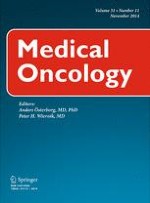Published in:

01-11-2014 | Original Paper
The role of B7-H1 in gastric carcinoma: clinical significance and related mechanism
Authors:
Dong Jiang, Yun-yun Xu, Fang Li, Biao Xu, Xue-guang Zhang
Published in:
Medical Oncology
|
Issue 11/2014
Login to get access
Abstract
The aim of this study was to investigate the role of co-stimulatory molecule B7-H1 in gastric carcinoma, to assess its clinical significance, and to explore related mechanism. Expression of B7-H1 and interferon gamma (IFN-γ) was evaluated by immunohistochemistry in 205 gastric carcinoma tissues and nonmalignant para-carcinoma tissues and 30 normal tissues. Expression data were correlated with clinicopathologic features of the patients. Furthermore, gastric carcinoma cell line SGC7901, MGC803, and AGS were employed to assess the expression of B7-H1 under the stimulation of IFN-γ. There was no detectable or weak amount of B7-H1 in normal tissue, while 43 % (88/205) of gastric carcinoma tissues and nonmalignant para-carcinoma tissues were confirmed with B7-H1 positive (p < 0.01). High B7-H1 expression was significantly associated with the age (p < 0.01), alcohol (p < 0.05), carcinoma location (p < 0.01), and differentiation (p < 0.05). Moreover, IFN-γ and CD3+ T cells infiltration were found in carcinoma tissues, but not in normal tissues. In addition, the expression of B7-H1 was also found in gastric carcinoma cell lines (SGC7901, MGC803 and AGS), and IFN-γ could increase its expression. Our data suggest that B7-H1 may represent a new early diagnostic marker for patients with well-differentiated gastric carcinoma. Furthermore, given its immune-inhibitory function, B7-H1 may represent a potential target in the treatment of gastric carcinoma.